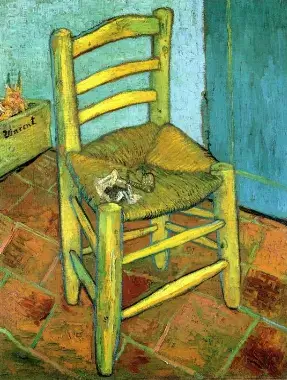The Symbolism of the Chair in Van Gogh’s Paintings

Vincent van Gogh is an extraordinary artist who has blessed the world with an expansive range of remarkable paintings. From Mediterranean landscapes and genre scenes to dynamic still lifes and dramatic self-portraits, van Gogh has tapped into different painting styles.
Among his many subjects, van Gogh painted a number of chairs in his paintings, which serve as fascinating glimpses into the artist’s world. Probably it’s because chairs are commonly found in the domestic settings that the artist drew inspiration from. Besides, the chairs were imbued with symbolic importance and represented a myriad of artist’s emotions. Let’s look at the symbolism of the chair in van Gogh’s paintings.
The Influence of Impressionism
In the late 1880s, van Gogh moved to Paris, where he was exposed to the Impressionists’ work. This had a profound impact on his art, and he began to experiment with brighter colors and looser brushstrokes. During this time, van Gogh became interested in painting chairs. He was drawn to their simple, functional form and how they could convey a sense of domesticity and warmth. He painted chairs in various settings, from humble peasant cottages to elegant bourgeois interiors.
Van Gogh and the Chairs
“A good armchair is a comfort and consolation in illness, work, and fatigue.”
-Vincent van Gogh
This saying by van Gogh conveys volume about what the artist thought of the chair and its significance in his life. It was something that provided him with a much-needed sense of companionship and comfort he experienced while struggling with mental health issues, isolation, and loneliness.
One of the most famous examples in van Gogh’s painting list is “The Chair” (1888), which features a simple wooden chair in his bedroom in Arles, France. The masterpiece is noteworthy for its bold colors and thick brushstrokes, which give the chair a sense of weight and presence. The chair is taken as the representation of van Gogh’s own presence in the room and in the world.
In other paintings, chairs are used to symbolize rest and comfort. For example, in “Vincent’s Chair with His Pipe” (1888), the chair is empty, but the presence of the pipe suggests that van Gogh has recently been sitting there. The chair appears soft and inviting, creating a sense of relaxation and comfort. And the addition of the red cushion only adds to the warmth of the setting showcased.
Chairs can also be used to represent absence or loss. In “Vincent’s Chair with Gauguin’s Pipe” (1888), the chair is again empty, but this time it is accompanied by a pipe belonging to van Gogh’s friend and fellow artist, Paul Gauguin. The painting was created during Gauguin’s visit to Arles, and the empty chair can be seen as a representation of his absence.
More than Just Chairs
At first glance, the chairs in Van Gogh’s paintings may seem like simple objects, but upon closer inspection, they reveal a deeper significance. In many of his works, chairs are used to create a sense of depth and perspective. They often serve as a point of reference that anchors the viewer’s gaze, providing a sense of stability and balance within the composition.
In other paintings, chairs are used to convey a sense of solitude and introspection. In his famous painting “The Bedroom,” for example, Van Gogh included a chair next to the bed, which has been interpreted as a symbol of the artist’s loneliness and emotional turmoil.
One of the earliest examples of van Gogh’s chair paintings is “The Potato Eaters,” completed in 1885. This painting shows a group of peasants gathered around a table, their faces illuminated by the light of a single lamp. The chairs they sit on are simple and worn, but van Gogh imbues them with a sense of solidity and permanence.
Additionally, chairs in Van Gogh’s paintings often serve as a way to explore the relationship between the human figure and the surrounding environment. In many of his portraits, the chair serves as a prop that enhances the subject’s pose and body language, creating a more dynamic and expressive image.
Conclusion
In conclusion, chairs in Vincent van Gogh’s paintings can have a range of symbolic meanings, representing the artist’s own presence, rest and comfort, absence or loss, and the human form itself. They are a testament to the artist’s ability to infuse everyday objects with deep meaning and significance, and they continue to inspire and captivate audiences around the world.
